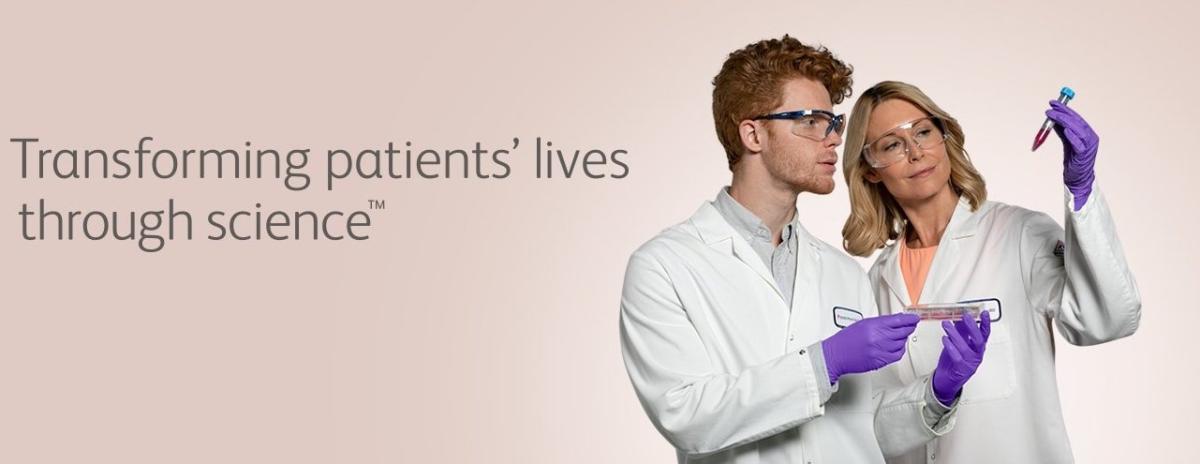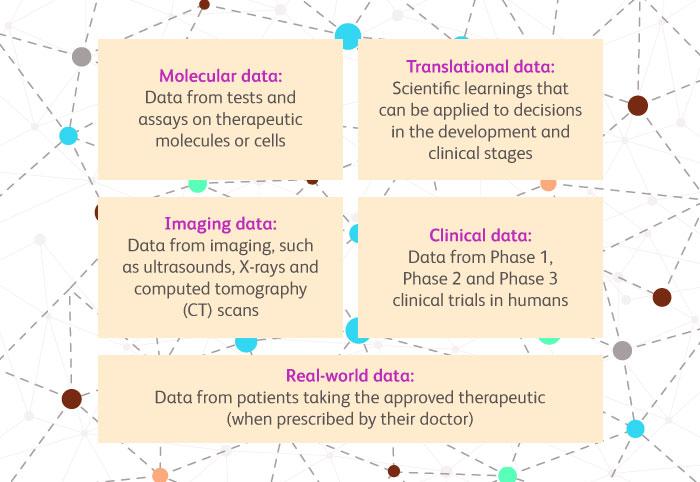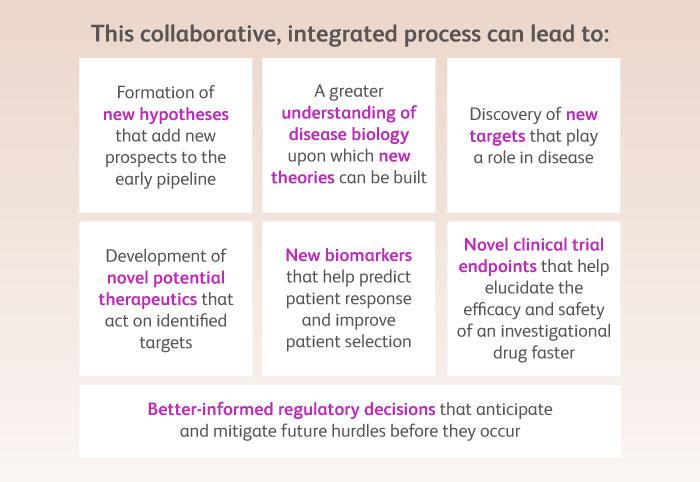From Numbers to Knowledge: Unlocking the Predictive Power of Data To Accelerate Transformative Science
Originally published on Bristol Myers Squibb News & Perspectives
Scientists and experts at Bristol Myers Squibb are working to revolutionize the process of drug development with sophisticated scientific strategies driven by technology. Using computer science, advanced clinical trial solutions and robust digital platforms, the company is accelerating and evolving its pipeline to get therapies to patients faster. But merely having these data and capabilities is not what propels progress — more important are the curiosity and questions that spur new discoveries, drive predictive analysis and yield meaningful conclusions from experts who ultimately transform data into innovation.
A strong foundation built over decades
Bristol Myers Squibb has deep biological knowledge of key pathways implicated in diseases and of pioneering treatment platforms and modalities. Harnessing this legacy, the company is leveraging past learnings in combination with robust novel datasets from both internal and external sources to amplify predictive power throughout all stages of the research and development (R&D) pipeline.
“We have a unique ecosystem of different types of data to work with.”
Mariann Micsinai-Balan, PhD, vice president and head of Data Sciences
“This library is built from vast amounts of data that has not only been collected over the years, but also interrogated in innovative ways. We have molecular, translational, imaging, clinical, wearable and real-world data that, like pieces of a puzzle, create a picture that advances our own understanding of the biology of the disease. Coupled with predictive machine learning methods, data helps us ask and answer questions, see the reality of the disease, the drug, and the types of patients we seek to help. They say every revolution in art is a return to realism. I think the greatest gift data science can bring us is a closer look at reality through the data.”
Just as important as the actual data is the integrity of that data. This is key as the data serve as the foundation upon which future efforts will be undertaken. We must ensure that data are accurate, reliable and free of bias. We must also ensure that the data are collected and used in an ethical, compliant way that respects the rights of others and maintains patient privacy.
“There are a lot of people involved in generating reliable data, and reliable data take more than one form,” said Matthew Trotter, PhD, vice president, Predictive Sciences. “There is literal reliability: have we captured it correctly? Has it become corrupted at any point? There is also reliability from an application perspective: does it match the research objective we are pursuing? We can generate a lot of data, but if we don't do so while asking the right questions, then both the data and our work with it may be less impactful than they could be.”
While our key datasets serve as the foundation for generating insights, it is the activities that surround the data and how scientists use them that drive decisions and enable new discoveries and advancements.
The key to unlocking true innovation
Much of the complex data generated by experiments, drug development or patient experiences do not, to the casual or even trained observer, yield immediate insights. Patterns and answers do not simply jump out for the taking but rather are elucidated via further analysis, interpretation and critical thinking. What are the questions that must be answered? What are the challenges that must be solved? Knowing what to ask and how to leverage answers and make predictions derived from identifying patterns in the data is the key that unlocks the true potential of data and turns them into knowledge that can inform decisions that advance the development of novel therapies. For example, if new, validated and precise clinical trial endpoints can be developed using data, then there is an opportunity to accelerate the path to approval for new therapeutics, thereby giving patients quicker access to medication.
“Bringing scientists with different skillsets together means that the questions we need to ask and the knowledge we need to generate, sometimes within the same dataset, can be different depending on what objectives we are pursuing, why we are pursuing them, and at which stage of the pipeline we are working.”
Matthew Trotter, PhD, vice president, Predictive Sciences
At Bristol Myers Squibb, teams of interdisciplinary scientists contribute to the generation, understanding and impactful use of data. One common misconception is that as capabilities in analyzing complex datasets grow, the need for experts shrinks; this is far from the truth. Advancements in informatics do not remove the need for human expertise. In fact, they broaden the disciplines that have traditionally been involved in drug discovery and development.
“All of our work is truly cross-functional, with everybody bringing their subject matter expertise together,” said Micsinai-Balan. “Biostatisticians, computer scientists, development teams, machine learning experts, safety colleagues, clinical operations, information technology (IT), biologists, chemists and clinical scientists, to name a few, all work together to not only generate usable data but, more importantly, to test hypotheses and figure out how we can do better for the patients we serve. We not only complement each other but learn from each other and help each other get the full picture.”
Within the company, these experts employ sophisticated technologies, such as artificial intelligence (AI) or machine learning, to produce a 360-degree view of specific diseases and specific patient types and to answer key questions from early research through treatment availability. This includes clinical trial recruitment, where both data and technology can be leveraged to help develop ways to recruit a more diverse and representative patient group compared to traditional approaches.
In addition to in-house experts, strategic collaborations help Bristol Myers Squibb achieve its goal of building industry-leading data science capabilities to drive advancements across the drug development continuum. “We have a lot of great, innovative collaborations in this space, which allow us to leverage our combined capabilities and share knowledge towards scientific progress that goes beyond incremental improvements to deliver potentially transformational advances,” said Trotter.
Key examples from the company’s early pipeline research include collaborations with Exscientia to accelerate the discovery of small molecule drug candidates using AI in various therapeutic areas including oncology and immunology, and Insitro to create disease models and drive therapeutic discovery and development for neurodegenerative disorders using machine learning, human genetics and functional genomics.
In the clinical stage, the company is working in collaboration with Owkin to enhance clinical trial design and execution with AI-powered approaches that optimize endpoint definitions, patient subgroups and treatment effect estimation with covariate adjustment and external control arms. Bristol Myers Squibb will apply Owkin’s AI capabilities to design potentially more precise and efficient clinical trials, initially for the company’s cardiovascular development program.
Illuminating new possibilities
These advances and experts come together to inform the ecosystem of drug development and help Bristol Myers Squibb achieve a deeper knowledge and understanding of the challenges that need to be solved. Together, data and powerful computers and algorithms, applied by teams of scientific and technological experts, help lead the way for the R&D organization from discovery to approval.
Most importantly, these advancements come together in the hope of accelerating the preclinical development timeline, clinical trials and overall time to approval.
“At the end of the day, the goal is to bring a successful and safe therapeutic to patients faster. Part of achieving this relies on the ability to conduct clinical trials in a timely, smart and efficient manner, and we rely on data, our experts and strategic collaborations to do so,” said Micsinai-Balan. “It is not only that science generates data, but data gives feedback to science and helps us search in novel directions.”
Never finished: How continual learning helps drive patient outcomes
Efforts to glean knowledge from data do not stop once a therapeutic is approved but rather shift in focus and priority. Data and the insights they provide can help improve how therapeutics are brought to patients. Bristol Myers Squibb works with real-world anonymized patient data to understand the patient journey, identify unmet needs and optimize actions both within the context of the approved medicine and within the pipeline.
“Our data allow us to understand a broad sampling of patient journeys throughout the disease and treatment course, and we can find new insights that we hope could have a meaningful impact on the scientific and patient community.”
Michael Sobotka, director, Commercial Data Science
At this stage, feedback from real-world experience with a medicine can help inform actions taken by the teams working directly with doctors and patients by providing useful information to the appropriate patients at the right point in their journey. Data collected at this stage can also help inform health economics and outcomes research (HEOR) efforts, which complement the information gained from the clinical development stage to guide decisions on patient access to medications.
“Our ultimate goal is to improve patient care by taking a broad view of what is happening in the disease and how it is managed and figuring out how to improve the patient journey. We aim to add value and be an active participant in healthcare in an impactful and appropriate way.”
Tom McDermott, vice president, Commercialization Insights & Analytics
These efforts include close collaboration with many departments at Bristol Myers Squibb, including R&D, as well as with academic and scientific partners throughout the industry, all working together toward a collective goal — improving patient care.
Innovation for a powerful purpose
As rapid technological advancements continue, innovations in computing, machine learning and AI are part of our science and, applied to our data, will be foundational to discovering, developing and delivering innovative medicines that help patients prevail over serious diseases. Bristol Myers Squibb’s commitment to being at the forefront of revolutionizing drug development through such innovation is evidenced by providing talented researchers and innovators the flexibility to drive R&D forward wherever the science takes them.




